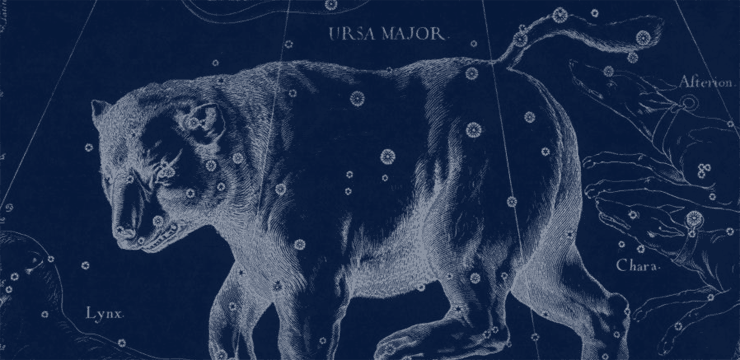The Constellations of Spring
April 2011 :
As the warm weather starts letting us know that seasonal change is really happening, we can look to the skies to remind us that springtime is once again coming to us. The Big Dipper isn’t actually in the north tight now; it’s virtually overhead, making us almost feel as if the best way to observe it is to face south, then push our necks up to the limit. When we do so, we can see that the Dipper is a true guide to the constellation marking springtime, Leo, the Lion. As the Big Dipper is overhead, Leo is found due south.
People often ask why the lion has no tail. He actually does, but it’s not considered part of his body. The tuft at tail’s end is the constellation Berenice’s hair. Queen Berenice was dismayed that her husband had to leave her and go to battle. She was so distraught at the possibility of losing him that she promised the gods she would donate her hair to them upon his safe return. He did; she did. The king then became so distraught that her waist-length hair had been shorn, until Berenice brought him outside and showed him the little place in the sky where her hair had been positioned.
The Big Dipper is also useful to find two more constellations welcoming the new season. Using the Dipper’s handle, follow the curve it makes downward to a very bright star, Arcturus, the brightest in Bootes, the Herdsman. Bootes was placed where he is to make sure the Big and Little Bears always stay in their proper positions in the north. Apparently he’s doing a great job. However, with bear herders not a prolific occupation these days, for us modern people an easier shape can be found. Bootes looks just like an ice cream cone, much more relevant especially for this time of year. Arcturus is the bottom of the cone. Then, follow two lines back toward the Dipper for the two sides of the cone, connecting them at their ends. One star above this line tells us this is only a single scoop. Below Arcturus and to the right is a tiny stream of stars marking the drip out of the cone’s bottom. Also, you’ll never forget the name Arcturus if you recall how you found it: You simply followed the curve, the arc, of the handle, to Arcturus.
Just off Bootes’s left, or east side, is what some feel is the ice cream scoop that fell off. It is the tiara formerly worn by Bacchus, Corona Borealis, the Northern Crown. Bacchus placed his crown in the sky as a sign of love, a story that should be told around mid-February. The slightly brighter star in the curved shape is easily remembered, as one of its names is Gemma, the Gem, or Jewel, of the Northern Crown.
Back to Arcturus, if you continue the line you started from the Big Dipper you should find another star, not as bright as Arcturus but the only really bright one in this part of the sky. You’ve found Spica, the sheaf of wheat in the hands of Virgo. Virgo, according to legend, represents the daughter of Ceres, the goddess of the harvest, charged with making sure we here on Earth were properly cared for. Unfortunately, Ceres’ daughter was kidnapped by Pluto, causing Ceres to become derelict in her duties until Jupiter stepped in to effect a compromise. Pluto was to release Ceres’ daughter for half the year. We see that in the sky, when Virgo rises out of the southeastern sky in early spring, a sign that Ceres is reunited with her. Ceres is then content, and returns to her terrestrial caregiving, until around September, when we note that Virgo begins to set early in the evening – Pluto has regained her. Ceres again begins her sadness, forgetting all about us, causing the ground to stop growth, and the cold to take over for the formerly comfortable planetary conditions. Then, just when we begin to wonder if the awful conditions will ever stop, Virgo once more shows itself in the southeast, and life begins again. To find this harbinger of spring, go back to the Big Dipper’s handle, follow the arc to Arcturus, then speed on down to Spica. You have now found the rather large boxlike, not princesslike, shape of Virgo.
When to Observe
Constellations
Related Topics




